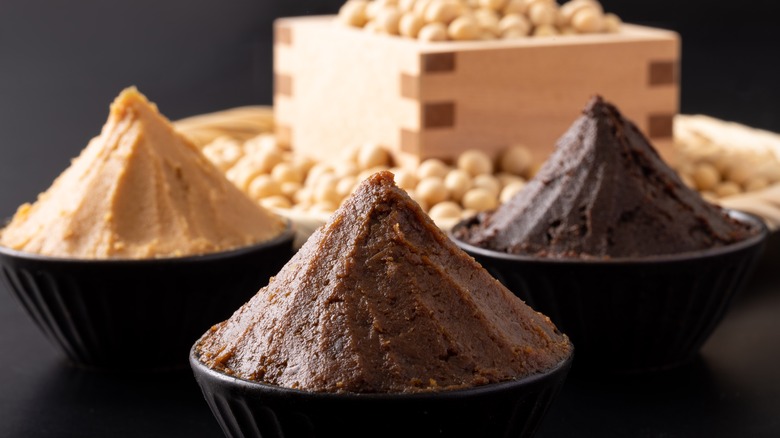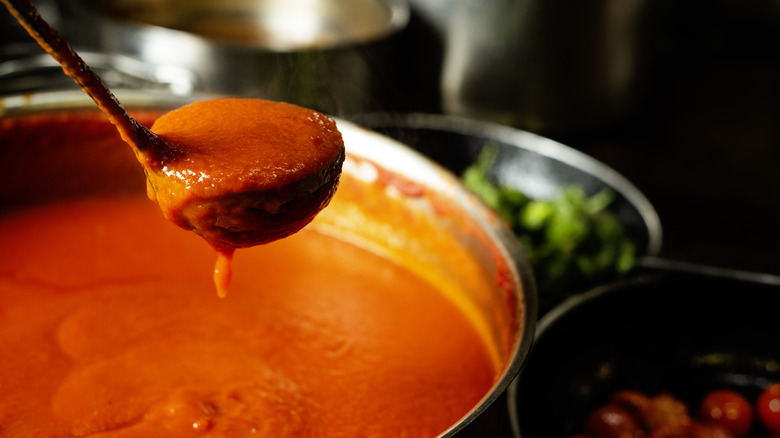The Umami Ingredient That'll Give Almost Any Pasta A Serious Upgrade
As far as easy dinners go, you can't beat a bowl of pasta with sauce. It's cheap, simple to make, and beloved by pretty much everyone. There's always room for a little experimentation, however, especially if you're getting tired of the same old spaghetti. Sometimes the sauce itself can use an upgrade — store-bought sauce, or even homemade sauce made with just a few ingredients, can come out a bit one-note. But if you've got a container of miso paste in the fridge, you've got the perfect umami bomb to make your pasta sauce taste like it was made by a professional chef.
Miso is a salty, fermented soybean paste that's most often used for making, of course, miso soup. Its earthy, meaty flavor can be used as a secret weapon to make countless foods taste magically better, including a batch of pasta sauce. All you have to do is mix a tablespoon or two in with your sauce of choice, and you'll get a more complex flavor without any heavy lifting in the kitchen. In fact, people will probably ask you how long you simmered your sauce, as miso gives dishes a richness that you can usually only achieve by slaving over a hot stove all day.
Miso contains just the right amount of umami
Miso paste is a popular ingredient in Japanese cooking because it's filled with natural glutamate, an amino acid that gives the paste the savory, meaty flavor known as umami. In addition to making the base for classic miso soup, you can find miso in recipes for everything from salad dressings to sauces to marinades to spreads. It's even a great way to elevate a chocolate cake. Glutamate is also naturally present in salty, savory foods with meat-like flavors such as parmesan cheese, mushrooms, and peanut butter, as well as meats like chicken, beef, and fish. A few tablespoons can give any dish a more enjoyable mouthfeel and richer flavor, so it's great to have around in the fridge.
If you want to get some of miso's umami goodness into your pasta sauce, just melt a tablespoon or two into the pot. For homemade sauce, the best time to add it is at the beginning, right as you're sweating the onions. If you melt it in with the butter or oil, you can build the sauce's flavor and still have some room for additional seasonings at the end of the recipe. If you find that the sauce still needs a little something when it's done, or you're working with store-bought sauce, dissolve a little more miso into some water or stock and stir it into the sauce to taste.
Miso pairs well with tomatoes
Miso is an excellent shortcut ingredient for pasta sauce because its earthy, mellow flavor pairs well with tomatoes. While you could also add mushrooms or parmesan cheese to your sauce, miso just packs in a lot more umami per tablespoon.
Keep in mind, however, that miso is very salty, so be sure to taste your sauce before you doctor it up with any of the fermented paste. If you're making your sauce from scratch, use miso sparingly and don't add too much extra salt during the cooking process without tasting what's going on in the pot. Store-bought pasta tends to already have plenty of sodium (unless you buy a variety that's specifically low-sodium), so be careful not to use too much miso, or risk making the sauce unbearably salty. If you're not sure how much salt there is in your store-bought sauce, check out the nutrition label; some brands contain as much as 1,000 milligrams of sodium in a 1-cup serving.
Once you've seasoned your sauce with miso to taste, make a mental note of how much of it you used to perfect your sauce. Then, the next time you're in the mood for a bowl of sauce-covered pasta, you'll know how much miso to add to the pot to make an excellent, elevated, and easy dinner.


